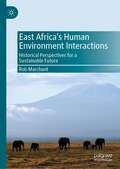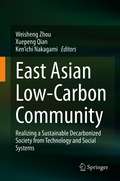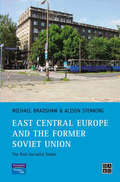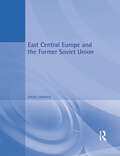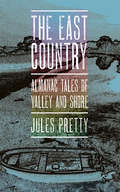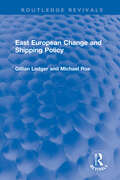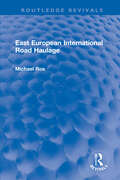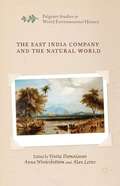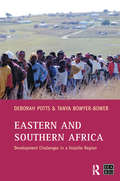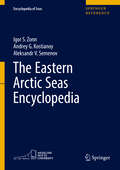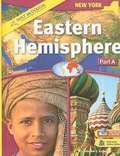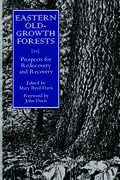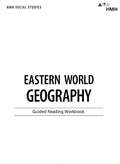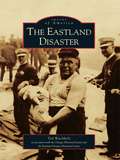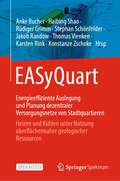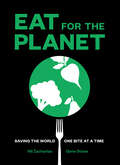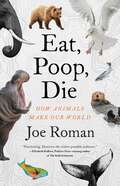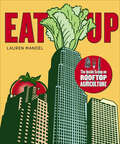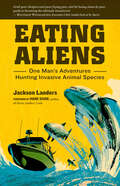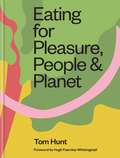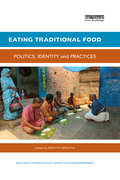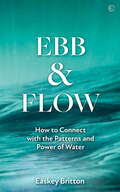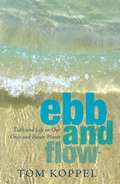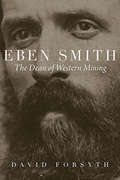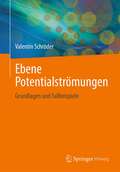- Table View
- List View
East Africa’s Human Environment Interactions: Historical Perspectives for a Sustainable Future
by Rob MarchantThis book is an ambitious integration of ecological, archaeological, anthropological land use sciences, drawing on human geography, demography and economics of development across the East Africa region. It focuses on understanding and unpicking the interactions that have taken place between the natural and unnatural history of the East African region and trace this interaction from the evolutionary foundations of our species (c. 200,000 years ago), through the outwards and inwards human migrations, often associated with the adoption of subsistence strategies, new technologies and the arrival of new crops. The book will explore the impact of technological developments such as transitions to tool making, metallurgy, and the arrival of crops also involved an international dimension and waves of human migrations in and out of East Africa. Time will be presented with a widening focus that will frame the contemporary with a particular focus on the Anthropocene (last 500 years) to the present day. Many of the current challenges have their foundations in precolonial and colonial history and as such there will be a focus on how these have evolved and the impact on environmental and human landscapes. Moving into the Anthropocene era, there was increasing exposure to the International drivers of change, such as those associated with Ivory and slave trade. These international trade routes were tied into the ensuing decimation of elephant populations through to the exploitation of natural mineral resources have been sought after through to the present day.The book will provide a balanced perspective on the region, the people, and how the natural and unnatural histories have combined to create a dynamic region. These historical perspectives will be galvanized to outline the future changes and the challenges they will bring around such issues as sustainable development, space for wildlife and people, and the position of East Africa within a globalized world and how this is potentially going to evolve over the coming decades.
East Asian Low-Carbon Community: Realizing a Sustainable Decarbonized Society from Technology and Social Systems
by Weisheng Zhou Xuepeng Qian Ken’ichi NakagamiThis book presents new vision of regional de-carbonization with concrete scheme design and substantial quantitative demonstration from original interdisciplinary studies. It provides new horizon for not only climate change, environmental conservation but also for international cooperation and peace in East Asia. The chapters introduce diverse low carbon society principles from local to global level with best practices integrating technology evolution and social innovation. While the book is designated for academics and the ultimate goal is to facilitate international climate regime making and environmental cooperation, local government and international organizations (United Nations, World Bank, and others) officers, researchers, international NGO/NPOs, consultants, students (particularly those studying environmental policy studies or international relationships), as well as reporters will find this book useful in broadening their understanding of low-carbon development in East Asia.
East Central Europe and the former Soviet Union: The Post-Socialist States (Developing Areas Research Group)
by Michael Bradshaw Alison StenningA comprehensive introduction to the important economic, social and political processes and development issues in this increasingly popular area of study. Employing a groundbreaking thematic approach the book centres its discussion on the interrelation between contemporary development theories and continuing transition issues in this huge and complex region.
East Central Europe and the Former Soviet Union: Environment and Society
by David TurnockSince 1898, the former communist countries of Eastern Europe have gained international prominence. The continuing socio-economic transition and the instability evident in areas like the Caucasus and Former Yugoslavia have drawn the western world into uneasy interactions with the region. At the same time, closer commercial and cultural contacts are providing opportunities for rewarding relationships which have now resulted in many of these countries joining the EU.This book provides detailed coverage of the transition from communism to a market economy. Covering the whole range of East Central European and former Soviet Union countries, it charts the diversity within the region, offering in-depth coverage of specific areas as well as a broad view of development across the region. The book is organised into three comprehensive sections: the historical, socio-economic and environmental. The socio-economic section considers the critical issues of restructuring to effect the transition from central planning to a market economy, while the historical material provides an essential context for the constraints and opportunities affecting the region. The environmental section places emphasis on results of environmental neglect inherited from communism as well as looking to the future implications of EU directives on the problems of biodiversity and pollution in the region.
The East Country: Almanac Tales of Valley and Shore
by Jules PrettyThe East Country is a work of creative nonfiction in which the acclaimed nature writer Jules Pretty integrates memoir, natural history, cultural critique, and spiritual reflection into a single compelling narrative. Pretty frames his book around Aldo Leopold and his classic A Sand County Almanac, bringing Leopold’s ethic—that some could live without nature but most should not—into the twenty-first century. In The East Country, Pretty follows the seasons through seventy-four tales set in a variety of landscapes from valley to salty shore. Pretty convinces us that we should all develop long attachments to the local, observing that the land can change us for the better.
East European Change and Shipping Policy (Routledge Revivals)
by Gillian Ledger Michael RoeOriginally published in 1996, this work begins by considering the changes that have taken place in the social, political and economic environment of Eastern Europe as a whole and then concentrates upon the shipping market with reference to Poland, Romania, Bulgaria, the Czech Republic and Hungary. A detailed model of the relationship between the shipping industry and the contextual changes that have occurred in the region in recent years is then developed before looking specifically at the liner shipping market of Poland and its market positioning within the context of competition in the North Atlantic and European Union operators.
East European International Road Haulage (Routledge Revivals)
by Michael RoeOriginally published in 1992, this study examines and analyses the role, planning and operation of international road hauliers based in the former East European countries. It outlines the problems they faced and the opportunities the new model of Europe should have provided at the time. It also emphasizes the role that West European hauliers could play in the market and the activities that the European Community carried out in this field in the light of 1992. It concludes by stressing the actions needed in the near future by governments and operators alike. Today it can be read in its historical context.
The East India Company and the Natural World
by Vinita DamodaranThis book is the first to explore the deep and lasting impacts of the largest colonial trading company, the British East India Company on the natural environment. The contributors - drawn from a wide range of academic disciplines - illuminate the relationship between colonial capital and the changing environment between 1600 and 1857.
Eastern and Southern Africa: Development Challenges in a volatile region (Developing Areas Research Group)
by Debby Potts T.A.S. Bowyer-BowerA unique and comprehensive introduction to contemporary development issues in East and Southern Africa, and represents a significant departure from the often descriptive approach adopted by existing regional and development texts on African regions. Each contribution is carefully chosen to highlight the theoretical basis to development issues, and the practical problems of implementing development plans, in this vital subregion. Overall this produces comprehensive and balanced coverage of historical, economic, political and social issues. The twin issues of globalisation and modernisation give the book a clear focus.
The Eastern Arctic Seas Encyclopedia
by Igor S. Zonn Andrey G. Kostianoy Aleksandr V. SemenovThis Encyclopedia is designed to accumulate and systematize our knowledge about the unique natural water areas - the Laptev, East Siberian and Chukchi seas, their wealth, the events that took place on its waters and shores, and the remarkable people whose lives were and are closely intertwined with the seas. The Encyclopedia contains about 1,500 terms and concepts related to the seas in alphabetical order. It describes geographical features: rivers, lakes, straits, bays; provides information about towns, seaports, transport communications, basic aquatic biological species, nature reserves, national and international programs for the study of the sea, research institutes, historical monuments, activities of prominent explorers and travelers, researchers and scientists. The Encyclopedia also includes a chronology of major historical events connected with the Eastern Arctic seas for more than 400 years.
Eastern Hemisphere: Part A (New York Student Edition)
by Christopher L. SalterThroughout this textbook, you will be studying the world's people, places, and landscapes. In addition, you will learn about the different kinds of features on Earth and about how geographers use themes and elements to study the world.
Eastern Old-Growth Forests: Prospects For Rediscovery And Recovery
by Anthony Cook Charles Schaadt Steve Comers Mary Byrd Davis J. Merrill Lynch Kathy SeatonEastern Old-Growth Forests is the first book devoted exclusively to old growth throughout the East. Authoritative essays from leading experts examine the ecology and characteristics of eastern old growth, explore its history and value -- both ecological and cultural -- and make recommendations for its preservation.The book provides a thorough overview of the importance of old growth in the East including its extent, qualities, and role in wildlands restoration. It will serve a vital role in furthering preservation efforts by making eastern old-growth issues better known and understood.
Eastern World Geography: Guided Reading Workbook
by Houghton Mifflin HarcourtGuided Reading Workbook (World Geography: Eastern World) 1st Edition with resource materials, workbooks/worksheets, and additional Materials
Eastland Disaster, The (Images of America)
by Chicago Historical Society land Disaster Historical Society Ted WachholzMore than 7,000 people living in the Chicago area and Michigan City, Indiana, eagerly anticipated Saturday morning, July 24, 1915. This particular Saturday was going to be anything but a routine summer day. Plans had been carefully made for it to be the social and entertainment event of the year, and for some, a lifetime. The fifth annual midsummer excursion and picnic had been organized by the employees of the Western Electric Company's Hawthorne Works. Thousands of carefree merrymakers would enjoy a festive day including a lovely cruise across Lake Michigan to an awaiting parade and day-long picnic. The day would conclude with an evening cruise back to Chicago. For thousands of hard-working immigrant laborers and their families and friends, it was going to be a day to remember. Instead, the day's scheduled event turned into a tragedy unlike any other. The SS Eastland, while still tied to the wharf, rolled into the Chicago River with more than 2,500 passengers on board. Nearly 850 people lost their lives, including 22 entire families. The ensuing struggle for survival, and the resulting death, heroism, cowardice, greed, and scandal gripped the city of Chicago.
EASyQuart - Energieeffiziente Auslegung und Planung dezentraler Versorgungsnetze von Stadtquartieren: Heizen und Kühlen unter Nutzung oberflächennaher geologischer Ressourcen
by Anke Bucher Haibing Shao Rüdiger Grimm Stephan Schönfelder Jakob Randow Thomas Vienken Karsten Rink Konstanze ZschokeDas Open-Access-Buch bietet ein Entscheidungshilfesystem für die Beheizung/Kühlung von Stadtteilen durch oberflächennahe geothermische Ressourcen.Die Energieversorgung von Stadtquartieren spielt eine Schlüsselrolle bei der Erreichung der Klimaschutzziele. In diesem Zusammenhang bietet der geologische Raum ein grundlastfähiges Wärmepotenzial für die städtische Wärmeenergieversorgung. Der optimierte Betrieb von Wärmepumpensystemen ist entscheidend für einen niedrigen Primärenergieverbrauch sowie eine effiziente und nachhaltige Nutzung der geothermischen Ressourcen. Die derzeitige Auslegungspraxis für geothermische Großanlagen basiert im Wesentlichen auf den gleichen Bedingungen, die für Einzelanlagen geschaffen wurden. Gefragt sind jedoch Quartierslösungen, die eine optimierte Anlagendimensionierung ermöglichen. EASyQuart entwickelt ein standortbezogenes Entscheidungshilfesystem für die Beheizung/Kühlung von Stadtquartieren unter Nutzung oberflächennaher geothermischer Ressourcen. Die Projektergebnisse umfassen Arbeitsabläufe, Bewertungskriterien und wissenschaftliche Instrumente, die helfen sollen, eine wirtschaftlich ungünstige Systemdimensionierung zu vermeiden. Auf Basis der Ergebnisse sollen Auslegungsverfahren und regulatorische Rahmenbedingungen flexibilisiert werden.
Eat for the Planet: Saving the World One Bite at a Time
by Nil Zacharias Gene Stone“An indispensable guide for anyone who wants to live to age 100—by making sure there’s a livable world when you get there.” —Dan Buettner, New York Times–bestselling author of The Blue ZonesDo you consider yourself an environmental ally? Maybe you recycle your household goods, ride a bike, and avoid too much air travel. But did you know that the primary driver of climate change isn’t plastics, or cars, or airplanes? Did you know that it’s actually our industrialized food system? In this fascinating new book, authors Nil Zacharias and Gene Stone share new research, intriguing infographics, and compelling arguments that support what scientists across the world are beginning to affirm and uphold: By making even minimal dietary changes, anyone can have a positive, lasting impact on our planet. If you love the planet, the only way to save it is by switching out meat for plant-based meals, one bite at a time.“This fascinating, easy-to-read book will give you still another reason to eat plants and not animals: you will be doing a world of good—literally!” —Rip Esselstyn, #1 New York Times–bestselling author of Plant-Strong“Eating plants is not just good for your own health, it’s imperative for the health of the planet. This well-argued, well-written book makes it clear why everyone should consider a plant-based diet today.” —Michael Greger, MD, New York Times–bestselling author of How Not to Die“Possibly the single most important environmental book I’ve read in years. A must for everyone.” —Kathy Freston, New York Times–bestselling author of The Lean
Eat, Poop, Die: How Animals Make Our World
by Joe RomanNAMED A TOP-TEN BEST BOOK OF 2023 BY SCIENTIFIC AMERICAN A &“fascinating&” exploration (Elizabeth Kolbert) of how ecosystems are sculpted and sustained by animals eating, pooping, and dying—and how these fundamental functions could help save us from climate catastrophe. If forests are the lungs of the planet, then animals migrating across oceans, streams, and mountains—eating, pooping, and dying along the way—are its heart and arteries, pumping nitrogen and phosphorus from deep-sea gorges up to mountain peaks, from the Arctic to the Caribbean. Without this conveyor belt of crucial, life-sustaining nutrients, the world would look very different. The dynamics that shape our physical world—atmospheric chemistry, geothermal forces, plate tectonics, and erosion through wind and rain—have been explored for decades. But the effects on local ecosystems of less glamorous forces—rotting carcasses and deposited feces—as well as their impact on the global climate cycle, have been largely overlooked. The simple truth is that pooping and peeing are daily rituals for almost all animals, the ellipses of ecology that flow through life. We eat, we poop, and we die. From the volcanoes of Iceland to the tropical waters of Hawaii, the great plains of the American heartland, and beyond, Eat, Poop, Die, &“compulsively readable&” (Shelby Van Pelt), takes readers on an exhilarating and enlightening global adventure, revealing the remarkable ways in which the most basic biological activities of animals make and remake the world—and how a deeper understanding of these cycles provides us with opportunities to undo the environmental damage humanity has wrought on the planet we call home.
Eat Up: The Inside Scoop on Rooftop Agriculture
by Lauren MandelFrom roof to table – urban food has reached new heights.Soaring prices and concerns about chemical-laden fruits and vegetables increasingly drive us to grow our own healthy food close to home. In cities, however, vanishing ground space and contaminated soils spur farmers, activists, and restaurateurs to look to the skyline for a solution. The hunger for local food has reached new heights, and rooftops can provide the space that cities need to bring fresh, organic produce to tables across North America.The first full-length book to focus entirely on rooftop agriculture, Eat Up views this growing movement through a practitioner's lens, explaining:Structural, access, and infrastructural considerationsZoning and building codesProven growing techniquesBusiness and marketing strategiesThis graphically rich guide provides inspiration and advice to aspiring growers through photographs of successful rooftop farms and gardens and interviews with industry professionals. Easy-to-use checklists and a decision tree are included to help gauge the viability of each unique rooftop opportunity. Essential reading for home gardeners, entrepreneurs, restaurateurs, policy makers, academics, and designers, Eat Up takes urban agriculture to a whole new level, proving that rooftop farming is not just pie in the sky—it is the future of urban food.Lauren Mandel holds a master's degree in landscape architecture from the University of Pennsylvania and a bachelor of arts degree in environmental science. She is a project manager and rooftop agriculture specialist at Roofmeadow, where she designs green roofs and oversees green roof and rooftop agriculture projects around the country.
Eating Aliens: One Man's Adventures Hunting Invasive Animal Species
by Hank Shaw Jackson LandersNorth America is under attack by a wide range of invasive animals, pushing native breeds to the brink of extinction. Combining thrilling hunting adventures, a keen culinary imagination, and a passionate defense of the natural environment, Eating Aliens chronicles Landers’ quest to hunt 12 invasive animal species and turn them into delicious meals. Get ready to dig into tacos filled with tasty black spiny-tailed iguana!
Eating for Pleasure, People & Planet
by Tom Hunt'If we could all live and eat a little more like Tom the world and the food chain would be in much better shape.' Anna Jones'This book is like a hybrid of Michael Pollan and Anna Jones. It combines serious food politics with flavour-packed modern recipes. This is a call-to-arms for a different way of eating which seeks to lead us there not through lectures but through a love of food, in all its vibrancy and variety.' Bee WilsonTom's mission is to teach a way of eating that prioritises the environment without sacrificing pleasure, taste and nutrition.Tom's manifesto, 'Root to Fruit' demonstrates how we can all become part of the solution, supporting a delicious, biodiverse and regenerative food system, giving us the skills and knowledge to shop, eat and cook sustainably, whilst eating healthier, better-tasting food for no extra cost.
Eating Traditional Food: Politics, identity and practices (Routledge Studies in Food, Society and the Environment)
by Brigitte SebastiaDue to its centrality in human activities, food is a meaningful object that necessarily participates in any cultural, social and ideological construction and its qualification as 'traditional' is a politically laden value. This book demonstrates that traditionality as attributed to foods goes beyond the notions of heritage and authenticity under which it is commonly formulated. Through a series of case studies from a global range of cultural and geographical areas, the book explores a variety of contexts to reveal the complexity behind the attribution of the term 'traditional' to food. In particular, the volume demonstrates that the definitions put forward by programmes such as TRUEFOOD and EuroFIR (and subsequently adopted by organisations including FAO), which have analysed the perception of traditional foods by individuals, do not adequately reflect this complexity. The concept of tradition being deeply ingrained culturally, socially, politically and ideologically, traditional foods resist any single definition. Chapters analyse the processes of valorisation, instrumentalisation and reinvention at stake in the construction and representation of a food as traditional. Overall the book offers fresh perspectives on topics including definition and regulation, nationalism and identity, and health and nutrition, and will be of interest to students and researchers of many disciplines including anthropology, sociology, politics and cultural studies.
Ebb and Flow: How to Connect with the Patterns and Power of Water
by Easkey BrittonAn exploration of water's power to heal us, inspire us and offer us spiritual meaning. This is a feminist reimagining of the meaning of power through the lens of water. Easkey offers a range of wellness practices to encourage the reader to connect with water as healer, restoring a relationship of care.Our strength lies in being soft like water. This book is about the power we gain by connecting to water. It&’s about how we can restore our relationship with the world's different bodies of water, and by doing so, restore both the water and ourselves. By sharing Easkey's own experiences as surfer and marine scientist, as well as those of many of her mentors who are at the forefront of water protection and activism around the world, it guides readers into reimagining the spirituality of water and restoring our innate connection with this lifeblood of the planet.The book also provides the reader with water-inspired strategies to restore calm, reduce stress and soothe anxiety. These range from simple breathing and visualization exercises to undertaking a journey from a water source to the ocean in order to forge a deep connection with the water. The emphasis is as much on the benefit to water as it is to the individual, and on creating a culture of reciprocity and care. By regaining this lost connection with water, we learn to develop an empathic connection with the force of all life and in the process restore our own hearts and minds.
Ebb and Flow: Tides and Life on Our Once and Future Planet
by Tom KoppelEbb and Flow was named one of 2007’s "best science books" by Peter Calamai, science editor of the Toronto Star [Dec. 30, 2007]. He calls it a "wonderful resource book. Tom Koppel seems to have visited or read about every place with unusual tides and water currents, yet he wears this scholarship lightly." Tides have shaped our world. They have carved out shorelines, transformed early life on Earth, and altered the course of human civilization. Tides frustrated Alexander the Great and Julius Caesar, and aided General MacArthur. They govern the way our planet moves, provide us with an alternative source of energy, and may be aggravating global climate change. Drawing on science, history, and personal memories, Koppel’s fascinating book engages and enlightens, demonstrating that a subject we take for granted affects all our lives. He weaves together three grand narratives, exploring how tides impact coasts and marine life, how they have altered human history and development, and how science has striven to understand the surprisingly complex way in which tides actually work.
Eben Smith: The Dean of Western Mining (Mining the American West)
by David ForsythDavid Forsyth recounts the life of Eben Smith, an integral but little-known figure in Colorado mining history. Smith was one of the many fortune seekers who traveled to California during the gold rush and one of the few who found what he sought. He moved to Colorado in 1860 with business partner Jerome Chaffee and over the next forty-six years was involved in mining in nearly every major camp in the state, from Central City to Cripple Creek, and in the development of mines such as the Bobtail, Little Jonny, and Victor. He was eulogized by the Denver Post and Denver Times as the “dean of mining in Colorado.” The mining teams Smith formed with Chaffee and with industrialist David Moffat were among the most successful and respected in Colorado, and many in the state held Smith in high regard. Yet despite the credit he received during his lifetime for establishing Colorado’s mining industry, Smith has not received much attention from historians, perhaps because he was content to leave public-facing duties to his partners while he concerned himself with managing mine operations. From Smith’s early years and his labor in the mines to his rise to prominence as an investor and developer, Forsyth shows how Smith used the mining and milling knowledge he acquired in California to become a leader in technological innovation in Colorado’s mining industry.
Ebene Potentialströmungen: Grundlagen und Fallbeispiele
by Valentin SchröderDas Buch zielt darauf ab, Studierenden des Maschinenbaus, der Verfahrens- und Umwelttechnik sowie des Wasserbaus den Einstieg in das Thema ebener Potentialströmungen zu vermitteln. Hierbei werden grundlegende Zusammenhänge (z.B. Stromfunktion, Potentialfunktion, usw.) abgeleitet. Dies geschieht in detaillierter Vorgehensweise („Step by Step“), sodass der Leser beim Nachvollziehen der Ableitungsschritte auf keine Verständnisschwierigkeiten stoßen sollte. Mathematische Grundlagen der Ingenieurwissenschaften werden bei der Benutzung des Buchs vorausgesetzt. Neben dem genannten Basiswissen ebener Potentialströmungen tragen zahlreiche Anwendungsbeispiele zum besseren Verständnis der Grundlagen bei. Auch hier wird großer Wert auf eine gut strukturierte, leicht nachvollziehbare Vorgehensweise gelegt. In den meisten Fällen kommt hierbei ein Tabellenkalkulationsprogramm zum Einsatz, was sich als eine nicht zu unterschätzende Hilfe erweist.
